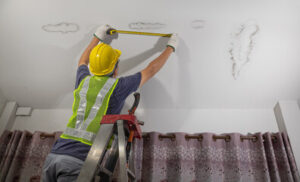A reputable roofing contractor will keep ideal client fulfillment at the highest stage of their administrations. They will likewise be focused on the security of their clients and workers.
Many roofers also offer exterior services such as gutters, siding and windows. They gain standing with manufacturers and can offer substantial warranties on their work.

A roofing contractor is a construction professional who has the knowledge, skills, and experience to install, maintain, repair, alter, or extend roofs of all types. This includes the installation and maintenance of roof accessories such as flashings, gutters, metal roof coverings, and chimney caps. Roofing contractors should also be competent in repairing or replacing wood roof sheathing and fascia.
The experience that roofing contractors gain over time is invaluable, as it allows them to anticipate and address unique project challenges with ease. It also ensures that they will deliver high-quality results. In addition, they understand the structural integrity and longevity of different roofing materials and how to properly install them.
When selecting a roofing contractor, look for one who has a solid reputation and excellent customer service. Ask for references and check out their website for reviews. Check if they use subcontractors and whether their work is insured. A reputable roofing company will have accreditations from insurance companies and offer warranties on their work.
Besides ensuring that the roof is constructed according to specifications, roofing contractors are also responsible for preparing the roof-deck surface for insulation. This will involve removing existing materials, cleaning the surface, and then priming and painting it to protect it from water and sun damage. Roofing contractors may also be required to install ventilation systems on the roof or make adjustments for proper air flow.
Many roofing contractors have a strong working knowledge of various types of roofing material and their performance and durability factors. They also know how to properly align and attach shingles in order to create a durable, aesthetically pleasing, and watertight roof. Choosing an experienced roofing contractor is an investment in your home, as quality workmanship and a durable roof can reduce future expenses on repairs or replacements.
Some roofing contractors specialize in a particular type of roof, such as shingle or flat roofs. Others provide a more comprehensive range of exterior services, such as siding and window installations. Those who have a broad expertise in home improvement often offer competitive pricing and can handle multiple projects simultaneously. They also have standing with manufacturers, which allows them to offer attractive material warranties.
Licensing
The construction industry is one of the most heavily regulated industries in the United States. Roofing contractors are no exception. The majority of States require all roofing contractors to be licensed by the state before they can start their work. These requirements vary by State, but most include a background check, proof of insurance and sometimes even a bond. In addition to State licensing, some localities may also have their own requirements for roofing contractors.
For instance, in New Jersey, roofing contractors are required to be licensed to perform any home improvement work that affects the roof or other exterior parts of a residential property. This includes installation of windows and siding, in addition to the roofing itself. In order to become a licensed contractor, an individual must pass a trade exam and provide proof of worker’s compensation and general liability insurance.
In Alaska, roofing contractor work is regulated by the Department of Commerce, Community and Economic Development, Division of Corporations, Business and Professional Licensing. In order to get a license, an applicant must pass a trade exam, take the Alaska Craftsman Home Program within two years prior to applying for a commercial or residential contractor license and have workers’ compensation and liability insurance in place.
Many States do not require roofing contractors to be licensed, but those that do typically require that the individual has at least two years of experience and passes a trade and law exam. Applicants must also submit their business information and Proof of insurance.
Some States, such as Tennessee, require a contractor to be licensed for any work that involves the roof or other structural components of a building. This requirement is separate from the state’s general contractor licensing requirements, and it applies to both commercial and residential projects.
In some states, such as Illinois and California, roofing contractors must be licensed if they perform asbestos removal or other work that requires the use of an asbestos-containing product. This is because asbestos can pose a health risk to those who come into contact with it. In addition to this, these states require that a contractor be licensed before bidding on a project.
Insurance
Roofing Contractors are exposed to a unique set of risks and must carry specific forms of insurance. These include general liability, workers’ compensation, commercial auto and inland marine. These policies can protect the business from unforeseen incidents that arise during a project. The cost of these insurance policies will vary depending on the coverage needed, prior claims and other pricing factors. For example, the number of employees and the size of the payroll will significantly affect premium costs.
General liability insurance for roofing contractors covers third-party injuries and property damage. For instance, if a tool misfires and damages a customer’s skylight, this policy can pay for the legal costs and restoration expenses. Similarly, if an employee is injured on the job, workers’ compensation insurance will pay for medical expenses and lost wages.
Professional negligence insurance, also known as errors and omissions coverage, is another essential policy for roofing businesses. This type of insurance covers the cost of a lawsuit resulting from misrepresentation, inaccurate advice or failure to perform a service. It can also cover legal fees and settlements arising from the negligent conduct of employees.
Builders risk insurance is another policy that is required by most contracting firms. It protects a building under construction or renovation from fire and weather-related damage. It can also cover the equipment and materials that are being transported between projects. This is a must-have for any roofing company.
Lastly, any vehicles used for business purposes need to be covered by commercial auto insurance. Inland marine insurance is a necessary addition for companies that transport high-value equipment on a regular basis. It covers the equipment against theft, loss and damage while in transit between work sites.
Choosing the right roofing contractor is an important decision for your home or commercial structure. There are many things to consider, including experience, licensing and insurance coverage. It is best to choose a contractor with an excellent reputation and an up-to-date insurance policy. Before hiring a contractor, ask for an Accord Form from their insurance broker. This document will list the insurers, policy numbers and dates of coverage. If you are unsure of the authenticity of this document, contact the broker directly and request the direct names and phone numbers of the policy carriers. This will help you avoid being duped by a fake or lapsed policy.
Reputation
You can learn a lot about a company from their initial interactions with you. How quickly and easily they answer your questions, schedule an inspection or quote a job, and follow up with you are good indicators of the level of care and professionalism you will receive from them throughout the project.
Word of mouth is a great way to find a contractor, but it’s also important to check online reviews and other public websites to get an overview of their reputation. Look for customer feedback, testimonials, and a gallery of work from past projects.
Having a well-defined brand and a quality website are also great signs of a roofing contractor that is committed to long term business success. If a roofing company is not invested in their brand, it may be indicative of poor business practices and a lack of trustworthiness.
A reputable roofing contractor will be able to provide you with a detailed contract that clearly outlines all the costs associated with your project. This includes materials, labor, and any other necessary expenses. They should be willing to go over the contract with you and answer any questions you have. If they are not interested in taking the time to be transparent about their pricing, this is a red flag and you should steer clear of them.
The best way to know if you’re dealing with a legitimate roofing contractor is to ask for recommendations from friends and family members who have had roofing work done recently. This will help you determine if the company’s prices are fair and if they have a solid track record of quality work.
Beware of contractors who are offering extremely low prices. You will typically get what you pay for, and low prices often indicate poor workmanship or substandard materials. In addition, be sure to read through any reviews posted on Google, Facebook, Angie’s List or HomeAdvisor and look at the specific comments pertaining to customer service. A good roofing contractor should have many positive reviews with few complaints. If a roofer has a lot of negative reviews, this is a strong indication that they are not a trustworthy contractor and should be avoided at all costs.






